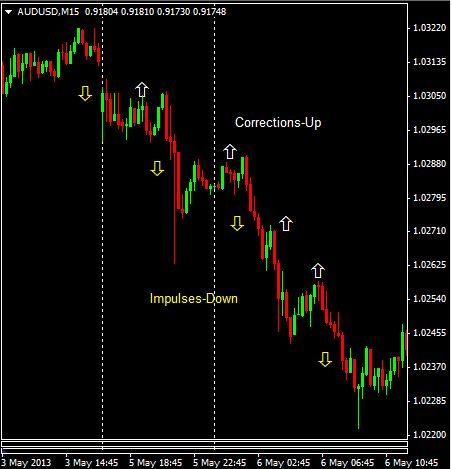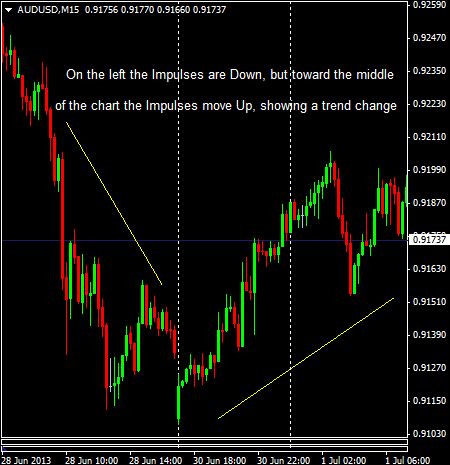Tips on How to Trade With the Trend and Spot Reversals
Trend trading seems like it should be easy, but when you’re first learning about trends your trades will likely end up on the wrong side of a lot of them. This is usually a result of not fully understanding the nature of trends, and the common mistake of trading against the trend because you think a reversal is starting. Here I’ll show you a few tips that’ll help you understand the dynamics of trends and trend reversals, and how to get in on both.
Impulses and Corrections
Price doesn’t move in one sustained direction for long. Even during a strong trend, the price impulses strongly, then corrects, then impulses and so on. Therefore, during a trend there are two main environments that occur–impulses and corrections.
Impulses occur in the direction of the larger trend, and typically cover a large price area, even though the impulse doesn’t necessarily last long. These are very strong moves, and ultimately the ones we want be trading with.
Corrections on the other hand are movements against the trend. Corrections cover less price area than impulses. The smaller corrections allow for the price to make head way in one particular direction.
Impulses and corrections can both be either up or down. There is a misconception that corrections are always moves to the downside. This is not true. A correction is simply a move against the more dominant trend. So if the impulses–large price moves–are to the downside, then corrections will be to the upside.
Figure 1. AUD/USD – 15 Minute Chart with Impulses (Yellow) and Corrections (White)

Trading with the Trend
Ideally you want to trade in the direction of the impulses, and corrections provide you with the entry points. Two potential entry methods were covered in my articles Trading the “Mini-Channel Breakout” and Capitalizing on Lower Highs and Higher Lows in Price.
Sounds simple. If the large moves are to the upside, you wait for a correction and then use an entry method (such as the ones described in the aforementioned articles) to get in and ride the impulse to a profit.
But a trend, which consists of both impulses and corrections, won’t last forever. Eventually the impulses will begin to move in the opposite direction.
Figure 2. AUD/USD – 15 Minute Chart with Trend Change

Spotting Potential Reversals
In order to trade with the trend, you also need to spot reversals. If you can’t spot reversals you will end trading with the old trend, and losing money.
Here are a couple ways to determine when a trend reversal may be occurring:
- An uptrend is created by higher swing highs in price, and higher swing lows. Therefore, if an uptrend fails to make a new high (creates a lower high), or creates a lower swing low, a reversal is potentially is underway. This doesn’t mean the uptrend is over, it simply means the uptrend is in question and therefore it is best not to trade until a new trend–either up or down–emerges.
A downtrend is created by lower swing lows in price, and lower swing highs. Therefore, if a downtrend fails to make a new low (creates a higher low), or creates a higher swing low, a reversal is potentially is underway. This doesn’t mean the downtrend is over, it simply means the downtrend is in question and therefore it is best not to trade until a new trend–either up or down–emerges.
- Watch the magnitude and direction of impulses. On the left half of figure 2 the impulses are down, in other words, the bigger moves are to the downside. On the right half of the chart, the moves to the upside are larger. Always ask yourself “In which direction are the moves larger?” When a shift occurs, as in figure 2, it signals a potential trend change. We always want to be on the side of the impulses, so trade in the direction of the biggest moves.
If you notice a market environment where both up and down moves are of similar magnitude, then you’re likely in a trading range or a choppy market environment because the price can’t make much progress one way or the other. I personally don’t trade during these times; I would much rather wait until a trend develops.
The Final Word
Most traders hear very early in their education that they should trade with the trend. Before that can happen though, you need to understand that price trends via impulses and corrections. Impulses and corrections both create a trend; it is simply the direction of the impulses which determines if the trend is up or down. In an uptrend watch for a lower high or lower low; in a downtrend watch for a higher low or higher high. These are both warning signs to avoid trend trading until a trend is re-established. Also, watch the magnitude of the impulses. When the larger moves start occurring in a different direction, a trend reversal is possibly underway. While it is not possible to know when every reversal will occur, or to always trade with the trend, avoid trading when the trend is in question and always try to trend trade in the direction of the largest moves (impulses).